Related Research Articles

Hook of Holland is a coastal village in the southwestern corner of Holland, hence the name; hoek means "corner" and was in use before the word kaap – "cape". The English translation using Hook is a false cognate of the Dutch Hoek, but has become commonplace. It is located at the mouth of the New Waterway shipping canal into the North Sea. The village is administered as a district of the municipality of Rotterdam. Its district covers an area of 18.53 km2, of which 14.19 km2 is land. On 1 January 2023 it had an estimated population of 10,560.

Stena Line is a Swedish shipping line company and one of the largest ferry operators in the world. It services Denmark, France, Germany, the United Kingdom, Ireland, Latvia, the Netherlands, Norway, Poland, Finland and Sweden. Stena Line is a major unit of Stena AB, itself a part of the Stena Sphere. It is a sister company to one of the world's leading tanker company Stena Bulk.

Sealink was a ferry company based in the United Kingdom from 1970 to 1984, operating services to France, Belgium, the Netherlands, Isle of Man, Channel Islands, Isle of Wight and Ireland.
Parkeston is a North Sea port village in Essex, England, situated on the south bank of the River Stour about one mile (1.6 km) up-river from Harwich. In 2018 it had an estimated population of 932.

High-speed Sea Service or Stena HSS was a class of high-speed craft developed by and originally operated by Stena Line on European international ferry routes. The HSS 1500 had an in-service speed of 40 knots (75 km/h).

MS Princess Seaways is a cruiseferry operated and owned by the Danish shipping company DFDS Seaways on a route connecting North Shields, England, to IJmuiden in the Netherlands. She was built in 1986 as Peter Pan by Seebeckwerft, Bremerhaven, Germany for TT-Line. Between 1993 and 2002, the ship was operated by TT-Line Company of Tasmania under the name Spirit of Tasmania a service across the Bass Strait. In 2002, the ship was sold to Fjord Line and renamed Fjord Norway for service from Denmark. In 2006, she was sold to DFDS Seaways and sailed as Princess of Norway before being given her current name in 2011.
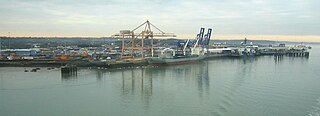
Harwich International Port is a North Sea seaport in Essex, England, and one of the Haven ports. It lies on the south bank of the River Stour one mile upstream from the town of Harwich, opposite the Port of Felixstowe. The port was formerly known as Parkeston Quay.
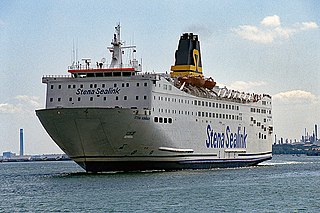
The MS Normandy was a ferry, last owned by the Singapore-based oil service company Equinox Offshore Accommodation, under charter to the Morocco-based ferry operator Ferrimaroc. She was built in 1981 by Götaverken, Gothenburg, Sweden, and first entered service in 1982 as MS Prinsessan Birgitta for Stena Sessan Line. She also served under the names MS St Nicholas and MS Stena Normandy.

MS Stena Europe is a ferry owned by Stena Line which operates between Algeciras and Tanger Med; under charter to Africa Morocco Link.

GNV Blu is a roll-on/roll-off ferry currently operated by Grandi Navi Veloci. She used to be owned by Stena Line and operated on the Karlskrona–Gdynia service. She was built in 1986 by Van der Giessen de Noord as MS Koningin Beatrix for SMZ. In 1989 she passed under Stena Line's ownership and in 2002 was renamed Stena Baltica. In 2013 she was sold to SNAV. On 23 October 2014, SNAV leased the ship to Panamanian company Ferry Xpress Panama to start operations on the Colon – Cartagena – Colon and Colon – Bocas del Toro – Colon routes. Since 2015 the vessel is operated by Trasmediterránea, and is currently used by Grandi Navi Veloci to serve the Bari–Durrës route.
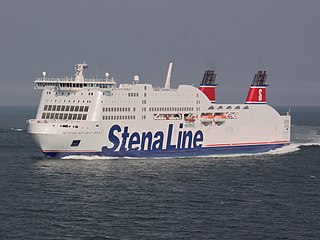
Stena Adventurer is a large roll-on/roll-off passenger (ro-pax) ferry operated by Stena Line on its Holyhead–Dublin route. She was launched in 2002 and entered service between Holyhead and Dublin the following year.

Port Link is a ro-pax ferry that was formerly operated by Sealink and Stena Line between Holyhead and Dun Laoghaire and later Stranraer and Larne / Belfast. Now it is used by ASDP Indonesia Ferry for Merak to Bakauheni line.
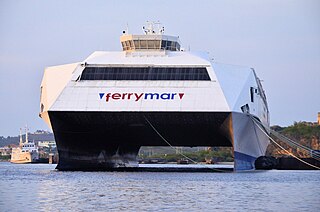
HSS Discovery was a high-speed ferry owned by Albamar Shipping Company. It is a member of the HSS 1500 class of high-speed ferries built for and designed by Stena Line from 1996 onwards. The vessel was previously named Stena Discovery and operated for Stena Line between Harwich International Port in the United Kingdom and Hook of Holland, the Netherlands.

HSS 1500 was the name of a model of Stena HSS craft developed and originally operated by Stena Line on European international ferry routes. The vessels were the largest high-speed craft in the world. Several design patents were registered to Stena Line in the development of the HSS.

Stoomvaart Maatschappij Zeeland was a Dutch ferry operator that ran services from the Netherlands to the United Kingdom between 1875 and 1989.

Stena Germanica is a large cruiseferry operated by Stena Line between Gothenburg and Kiel, together with MS Stena Scandinavica (2002). Between 2001 and 2010, as Stena Hollandica she operated on the Harwich to Hook of Holland service.
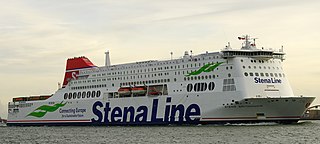
Stena Britannica, launched in 2009, is the second of two identical Ropax cruiseferries built by Wadan Yards in Warnemünde and nearby Wismar, Germany for Stena Line. The first of the two ships, launched in January 2010, was Stena Hollandica. Both ships operate across the southern North Sea between Harwich in Essex, England, and Hook of Holland, Netherlands, providing a twice daily service. The ships were specifically designed for this route.

Stena Hollandica, launched in January 2010, is the first of two identical Ropax ferries built by Wadan Yards in Warnemünde and nearby Wismar, Germany for Stena Line. The second of the two ships, launched towards the end of 2010, is Stena Britannica. Both ships operate (2012) across the southern North Sea between Harwich and Hook of Holland providing a twice daily service from each side. The ships were specifically designed for this route.
Cambridge Ferry was a 3,294 GRT train ferry that was built in 1963 for the British Railways Board. She was sold to Malta in 1992 and renamed Ita Uno. She was renamed Sirio in 1993 and reflagged to Panama in 1998. The ship was scrapped in Turkey in 2003.

Speedlink Vanguard was a 3,514 GRT train ferry which was built in 1973 as Stena Shipper. She was charted to a New Zealand operator on completion and renamed Union Wellington and saw further service as Alpha Express and Stena Shipper before entering service with Sealink as Speedlink Vanguard. The ship was involved in a collision with European Gateway in 1982, which sank the latter ship with the loss of six lives.
References
- 1 2 3 Ships Monthly, July 2008. Page 46
- ↑ Ships Monthly, July 2008. Page 47
- 1 2 3 Ships Monthly, July 2008. Page 48
- ↑ Stena Discovery
- ↑ Sunday Mirror Fast ferry axed
- ↑ "Stena Britannica". Archived from the original on 9 December 2012.
- ↑ "Stena Hollandica". Archived from the original on 20 December 2012.
- ↑ Aker Yards To build the world's largest ferries for Stena
- ↑ Harwich Hook of Holland 1893–2010. Published by Ferry Publications, PO Box 33, Ramsey, Isle of Man, IM99 4LP.
- ↑ Feeder Lines, pt 1 Archived 31 December 2009 at the Wayback Machine
- ↑ Harwich Hook of Holland 1893–2010. Published by Ferry Publications, PO Box 33, Ramsey, Isle of Man, IM99 4LP
- 1 2 "Välkommen till Fakta om Fartyg". Archived from the original on 2 August 2012.
- ↑ Harwich Hook of Holland 1893 to 2010. Published by Ferry Publications, PO Box 33, Ramsey, Isle of Man, IM99 4LP
- ↑ Harwich Hook of Holland 1893–2010. Published by Ferry Publications, PO Box 33, Ramsey, Isle of Man, IM99 4LP